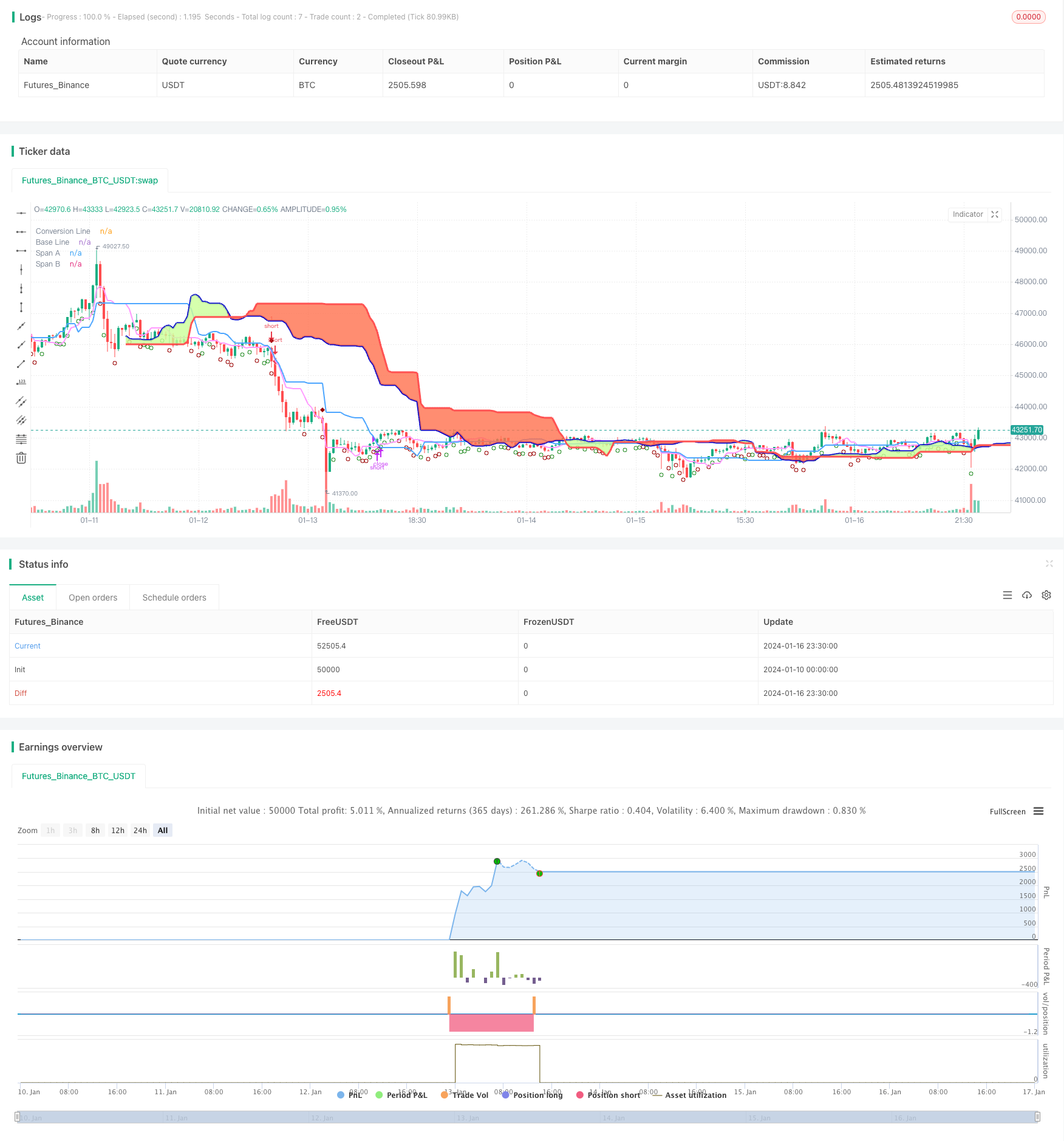
概述
这是一个基于一目均衡表指标设计的趋势追踪策略。该策略利用一目均衡表的转换线、基准线以及云层的形态,设定了非常严格的入场条件,同时使用简单的止损方式来关闭订单。该策略适用于长线趋势交易。
策略原理
该策略使用一目均衡表的转换线、基准线、前沿线A、前沿线B以及价格本身的关系来判断趋势方向和力度。具体判断标准如下:
- 当前云层展宽且价格在云层之上;
- 未来云层展宽;
- 基准线在云层之上;
- 转换线在基准线之上;
- 价格在转换线之上;
- 当前和未来的前沿线A、前沿线B、基准线以及转换线的角度都是向上;
当上述所有条件同时满足时产生买入信号;当所有条件取反时,产生卖出信号。
该策略同时设定了前沿线A作为止损线。当价格跌破止损线后,平掉相关仓位。
优势分析
这是一个条件非常严格的策略,所以可以有效避免虚假信号的干扰,从而锁定大趋势的机会。同时,策略利用多种指标判断趋势,避免单一指标出错的系统性风险。
该策略适合长线持有,可以减少交易频率,有助于降低交易成本和滑点的影响。
风险分析
该策略的止损线比较宽松,未来前沿线A。这可能导致单笔损失比较大的风险。可以考虑收紧止损线,或使用辅助指标进行风险控制。
另外,策略信号较少,可能错过一些短线机会。如果追求更高频率的交易,可以考虑降低部分入场条件的严格性。
优化方向
可以考虑在入场条件上进行松紧平衡,降低进入门槛从而获取更多信号;或者提高标准滤除更多噪音,锁定少而精的信号。
止损方式可以优化,试验自动止损或远程止损等方法,控制单笔损失。
可以测试不同参数对结果的影响,找到最优参数组合。也可以加入其他指标进行评分,实现更精确的订单管理。
总结
这是一个非常严格的趋势追踪策略。它利用一目均衡表的多个指标判断趋势方向和力度,避免假信号。同时采用宽松的止损方式锁定长线大趋势。这是一个优秀的策略思路,通过参数和止损的优化,可以成为一个非常实用的量化交易策略。
策略源码
/*backtest
start: 2024-01-10 00:00:00
end: 2024-01-17 00:00:00
period: 30m
basePeriod: 15m
exchanges: [{"eid":"Futures_Binance","currency":"BTC_USDT"}]
*/
//@version=3
strategy(title="BadaBing Ichimoku", shorttitle="BadaBing", overlay=true)
atr_period = input(title="ATR Period", defval=20)
conversion_period = input(title="Conversion Line Period", defval=9, minval=1)
base_period = input(title="Base Line Period", defval=26, minval=1)
span_b_period = input(title="Span B Period", defval=52, minval=1)
displacement = input(title="Displacement", defval=26, minval=1)
min_current_cloud_atr = input(title="Min Current Cloud ATR", type=float, defval=1.0)
min_future_cloud_atr = input(title="Min Future Cloud ATR", type=float, defval=0)
check_base_line_above_cloud = input(title="Check Base Line above Cloud?", type=bool, defval=true)
check_conversion_line_above_base_line = input(title="Check Conversion Line above Base Line?", type=bool, defval=true)
check_price_above_conversion_line = input(title="Check Price above Conversion Line?", type=bool, defval=true)
check_span_a_point_up = input(title="Check Current Span A is pointing Up?", type=bool, defval=false)
check_span_b_point_up = input(title="Check Current Span B is pointing Up?", type=bool, defval=false)
check_future_span_a_point_up = input(title="Check Future Span A is pointing Up?", type=bool, defval=true)
check_future_span_b_point_up = input(title="Check Future Span B is pointing Up?", type=bool, defval=true)
check_base_line_point_up = input(title="Check Base Line is Pointing Up?", type=bool, defval=true)
check_conversion_line_point_up = input(title="Check Conversion Line is Pointing Up?", type=bool, defval=true)
bullish_color = #ccff99
bearish_color = #ff704d
span_a_color = #0000cc
span_b_color = #000066
conversion_color = #ff99ff
base_color = #4da6ff
bull_signal_color = #228b22
bear_signal_color = #990000
donchian(len) => avg(lowest(len), highest(len))
bchange(series) => series and not series[1]
conversion_line = donchian(conversion_period)
base_line = donchian(base_period)
future_span_a = avg(conversion_line, base_line)
future_span_b = donchian(span_b_period)
span_a = future_span_a[displacement]
span_b = future_span_b[displacement]
current_atr = atr(atr_period)
min_cloud_width = min_current_cloud_atr * current_atr
current_cloud_long_flag = span_a > (span_b + min_cloud_width)
current_cloud_short_flag = span_a < (span_b - min_cloud_width)
future_cloud_long_flag = future_span_a > (future_span_b + min_cloud_width)
future_cloud_short_flag = future_span_a < (future_span_b - min_cloud_width)
base_line_long_flag = check_base_line_above_cloud ? (base_line > span_a) : true
base_line_short_flag = check_base_line_above_cloud ? (base_line < span_a) : true
conversion_line_long_flag = check_conversion_line_above_base_line ? (conversion_line > base_line) : true
conversion_line_short_flag = check_conversion_line_above_base_line ? (conversion_line < base_line) : true
price_long_flag = check_price_above_conversion_line ? (close > conversion_line) : true
price_short_flag = check_price_above_conversion_line ? (close < conversion_line) : true
span_a_point_long_flag = check_span_a_point_up ? (span_a > span_a[1]) : true
span_a_point_short_flag = check_span_a_point_up ? (span_a < span_a[1]) : true
span_b_point_long_flag = check_span_b_point_up ? (span_b > span_b[1]) : true
span_b_point_short_flag = check_span_b_point_up ? (span_b < span_b[1]) : true
future_span_a_point_long_flag = check_future_span_a_point_up ? (future_span_a > future_span_a[1]) : true
future_span_a_point_short_flag = check_future_span_a_point_up ? (future_span_a < future_span_a[1]) : true
future_span_b_point_long_flag = check_future_span_b_point_up ? (future_span_b > future_span_b[1]) : true
future_span_b_point_short_flag = check_future_span_b_point_up ? (future_span_b < future_span_b[1]) : true
base_line_point_long_flag = check_base_line_point_up ? (base_line > base_line[1]) : true
base_line_point_short_flag = check_base_line_point_up ? (base_line < base_line[1]) : true
conversion_line_point_long_flag = check_conversion_line_point_up ? (conversion_line > conversion_line[1]) : true
conversion_line_point_short_flag = check_conversion_line_point_up ? (conversion_line < conversion_line[1]) : true
bada_long = bchange(current_cloud_long_flag)
or bchange(future_cloud_long_flag)
or bchange(base_line_long_flag)
or bchange(conversion_line_long_flag)
or bchange(price_long_flag)
or bchange(span_a_point_long_flag)
or bchange(span_b_point_long_flag)
or bchange(future_span_a_point_long_flag)
or bchange(future_span_b_point_long_flag)
or bchange(base_line_point_long_flag)
or bchange(conversion_line_point_long_flag)
bada_short = bchange(current_cloud_short_flag)
or bchange(future_cloud_short_flag)
or bchange(base_line_short_flag)
or bchange(conversion_line_short_flag)
or bchange(price_short_flag)
or bchange(span_a_point_short_flag)
or bchange(span_b_point_short_flag)
or bchange(future_span_a_point_short_flag)
or bchange(future_span_b_point_short_flag)
or bchange(base_line_point_short_flag)
or bchange(conversion_line_point_short_flag)
bada_color = bada_long ? bull_signal_color : bear_signal_color
plotshape(bada_long or bada_short, title="bada",
style=shape.circle,
location=location.belowbar,
color=bada_color,
transp=50)
bing_long = current_cloud_long_flag
and future_cloud_long_flag
and base_line_long_flag
and conversion_line_long_flag
and price_long_flag
and span_a_point_long_flag
and span_b_point_long_flag
and future_span_a_point_long_flag
and future_span_b_point_long_flag
and base_line_point_long_flag
and conversion_line_point_long_flag
bing_short = current_cloud_short_flag
and future_cloud_short_flag
and base_line_short_flag
and conversion_line_short_flag
and price_short_flag
and span_a_point_short_flag
and span_b_point_short_flag
and future_span_a_point_short_flag
and future_span_b_point_short_flag
and base_line_point_short_flag
and conversion_line_point_short_flag
bing_color = bing_long ? bull_signal_color : bear_signal_color
plotshape(bchange(bing_long or bing_short), title="bing",
style=shape.diamond,
location=location.abovebar,
color=bing_color,
transp=0)
c = plot(conversion_line, color=conversion_color, title="Conversion Line", linewidth=2)
b = plot(base_line, color=base_color, title="Base Line", linewidth=2)
p1 = plot(future_span_a, offset = displacement, color=span_a_color, title="Span A", linewidth=3)
p2 = plot(future_span_b, offset = displacement, color=red, title="Span B", linewidth=3)
fill(p1, p2, color = future_span_a > future_span_b ? bullish_color : bearish_color, transp = 60)
strategy.entry("long", true, 1, when=bing_long)
strategy.exit("stop", "long", stop=span_a)
strategy.close("long", when=close < base_line)
strategy.entry("short", false, 1, when=bing_short)
strategy.exit("stop", "short", stop=span_a)
strategy.close("short", when=close > base_line)